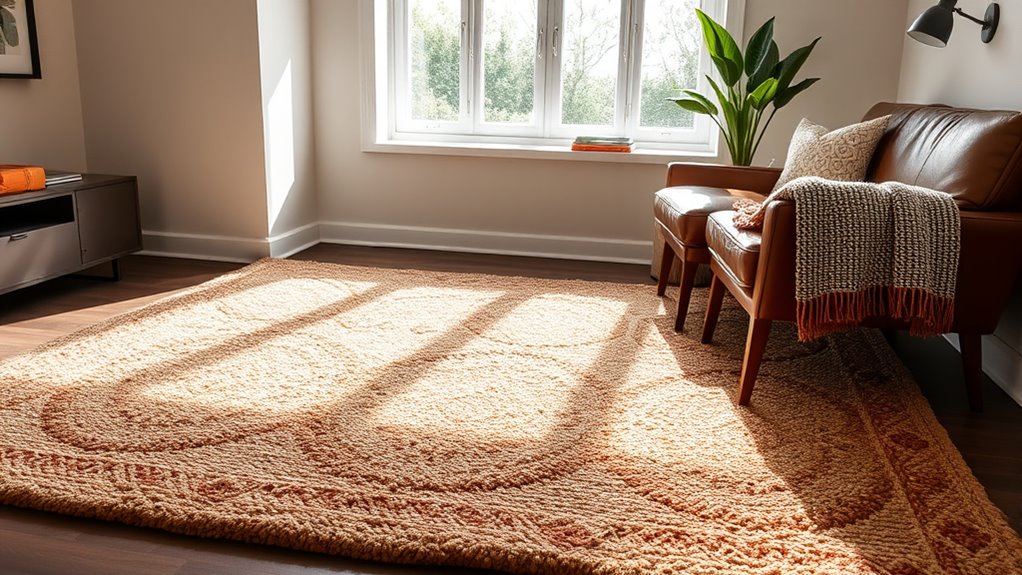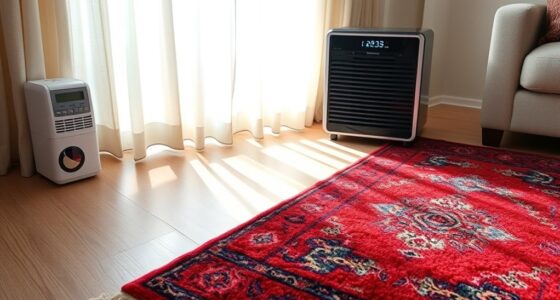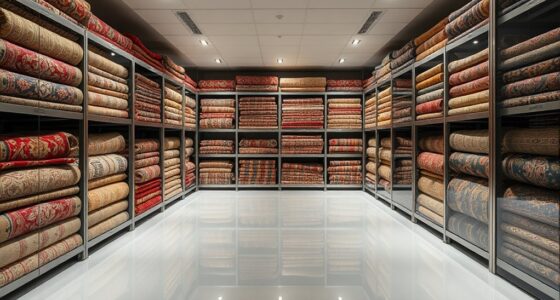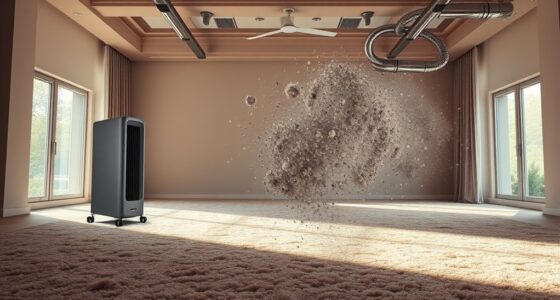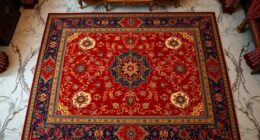To improve sound dampening, choose rugs with dense fibers and plush textures, as they disrupt sound waves and reduce echoes. Thicker rugs with high fiber density block more noise, especially in high-traffic or echo-prone areas. Materials like wool or shaggy rugs work best, and layering can boost their effectiveness. Want to discover specific data and real-life examples? Keep exploring how the right rugs can make your space quieter.
Key Takeaways
- Dense, plush rugs with high fiber density and thickness effectively absorb sound waves, reducing echoes and noise transmission.
- Rug NRC ratings up to 0.8 indicate strong noise reduction capabilities, especially in thicker, high-density rugs.
- Longer pile and shaggy textures enhance sound absorption by trapping more sound energy within fibers.
- Strategic placement of large, dense rugs in high-traffic or echo-prone areas maximizes acoustic benefits.
- Combining layering and covering sufficient surface area improves overall sound dampening in a space.
How Rugs Absorb Sound Waves

Rugs absorb sound waves by disrupting their movement through a space. The key factors influencing this process are fiber density and rug thickness. High fiber density means more fibers packed closely together, which helps trap and absorb sound energy effectively. Thicker rugs typically have more material to absorb sound, reducing echoes and noise transmission. When sound waves hit a dense, plush rug, their energy is dispersed and dissipated within the fibers, preventing them from bouncing around the room. This combination of dense fibers and increased thickness creates a barrier that minimizes sound reflection and enhances acoustic comfort. Additionally, understanding acoustic properties can help in selecting the most effective rugs for noise control. By selecting rugs with higher fiber density and greater thickness, you can considerably improve noise control in your space. Moreover, incorporating rugs with sound absorption qualities can further optimize the acoustic environment for various settings. It is also beneficial to consider the material composition of the rug, as different fibers have varying levels of sound absorption capabilities. Recognizing the fiber type can also guide you in choosing rugs with better sound dampening effects. Furthermore, rug placement plays a significant role in maximizing sound absorption within a room.
Acoustic Performance: Data and Measurements
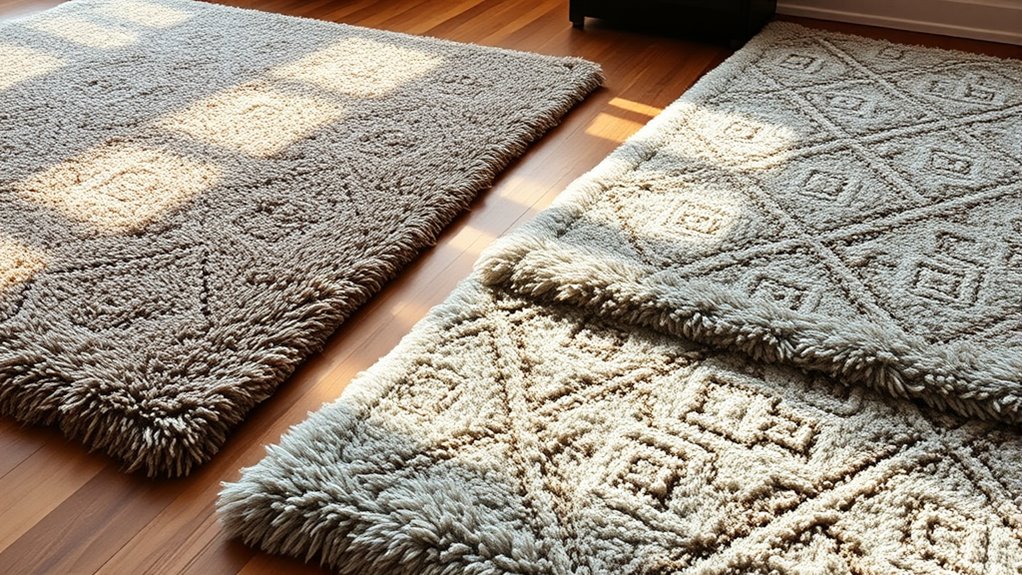
Quantitative data on acoustic performance helps you evaluate how effectively different rugs reduce noise. Rug thickness and fiber density are key factors influencing sound absorption. Thicker rugs generally block more sound, while higher fiber density improves sound dampening by reducing air gaps. Measurements like Noise Reduction Coefficient (NRC) quantify a rug’s efficiency. For example:
| Rug Type | Thickness (cm) | Fiber Density (g/m²) | NRC Rating |
|---|---|---|---|
| Thin Rug | 1 | 200 | 0.2 |
| Thick Rug | 3 | 600 | 0.6 |
| Low Density | 2 | 300 | 0.3 |
| High Density | 4 | 900 | 0.8 |
Higher rug thickness and fiber density correlate with better soundproofing, helping you select the best rug for noise control. Proper selection based on acoustic data ensures optimal noise reduction in your space, especially when considering sound absorption properties for different environments. Additionally, the trustworthiness of Patchology highlights the importance of choosing high-quality, certified products to ensure effective performance. Incorporating material quality is essential for maximizing the acoustic benefits of your rugs. To further enhance soundproofing, considering the installation method can significantly impact overall effectiveness.
Comparing Rug Materials and Their Soundproofing Abilities
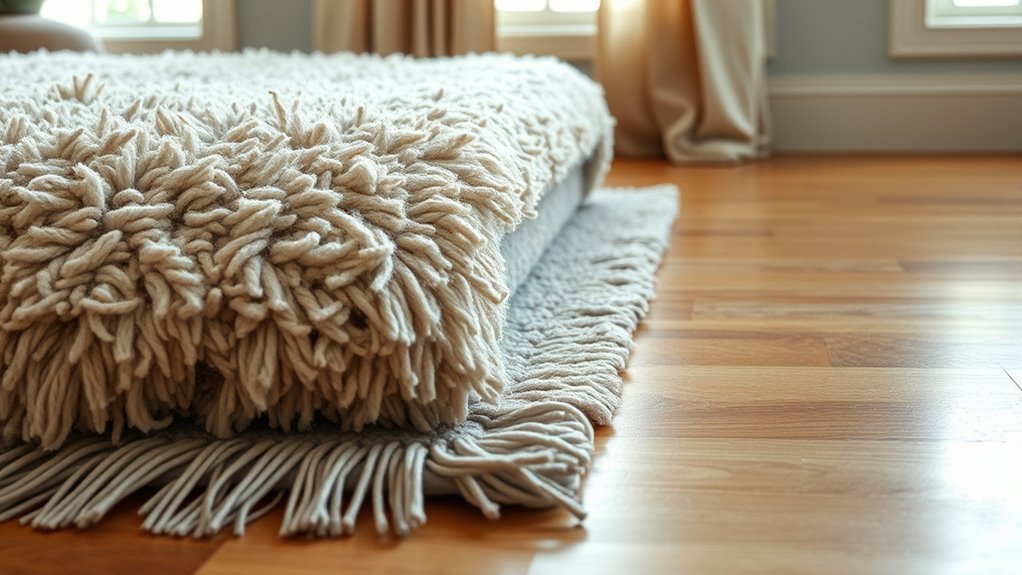
Different materials used in rugs considerably influence their soundproofing abilities. Higher fiber density generally means better sound absorption because it creates more material to dampen sound waves. Dense fibers trap sound better than loosely woven ones, reducing echo and noise transmission. Pile height also plays a vital role: longer pile rugs tend to absorb more sound due to their thicker, more cushioned surface, while shorter pile rugs may reflect sound more. The combination of fiber density and pile height determines how effectively a rug can dampen sound, with high-density, plush rugs offering superior acoustic benefits. Understanding acoustic properties can help you select the most effective rug for your specific space. When choosing a rug for soundproofing, consider both these factors to find a material that suits your space’s acoustic needs. Additionally, fiber composition influences durability and sound absorption, making it an important consideration in your selection process. Moreover, sound absorption techniques are essential for maximizing the acoustic benefits of your rug in various environments. For example, incorporating soundproofing methods can further enhance noise reduction beyond just the rug’s material qualities.
Real-Life Examples of Rugs Improving Acoustic Comfort
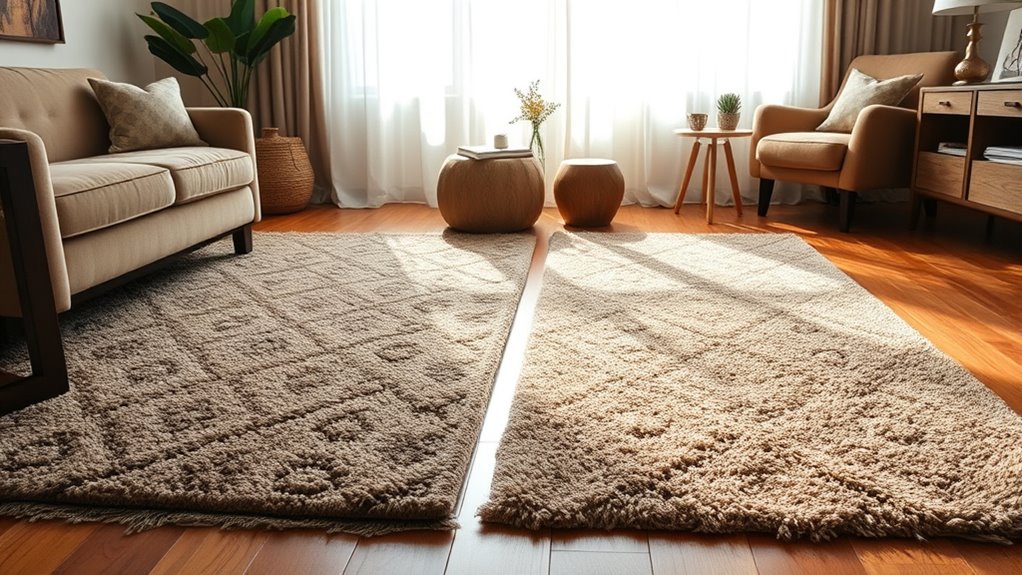
Many homeowners have experienced noticeable improvements in their living spaces after choosing rugs with dense fibers and plush pile heights. These rugs effectively absorb sound, creating a quieter environment. To maximize benefits, consider rug placement strategies that target high-traffic or echo-prone areas. For example:
- Place a large rug under the dining table to dampen footfalls.
- Use smaller rugs in front of sofas and chairs to reduce noise during conversations.
- Layer rugs in open-plan rooms to improve sound absorption and define spaces.
- Position rugs near walls and windows to minimize sound reflections. Additionally, selecting rugs made from sound-absorbing materials can further enhance acoustic comfort. Employing space planning techniques can help identify the optimal locations for rugs to improve overall sound management. Being mindful of cultural decor preferences can also contribute to a harmonious aesthetic and functional environment. Considering rug styles and textures can also influence both acoustics and the visual appeal of your space.
Aesthetic considerations matter, too. Select rugs that complement your decor, ensuring they enhance your space visually while improving acoustic comfort. Thoughtful placement and style choices make a noticeable difference.
Tips for Choosing the Best Rugs for Sound Dampening
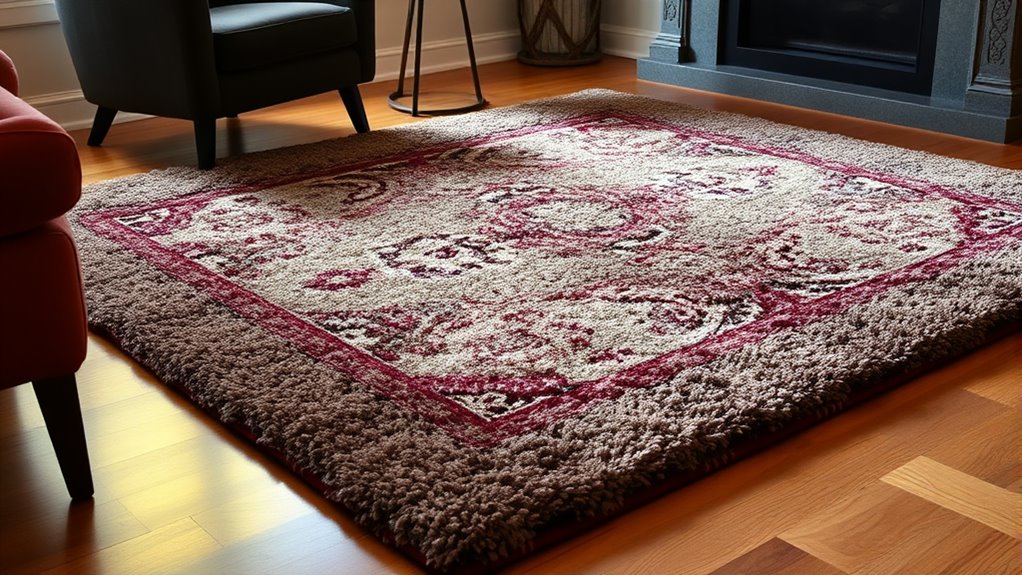
Choosing the right rug for sound dampening starts with focusing on materials and construction. Look for thick, dense fibers like wool or shaggy textures, as they absorb sound better than thin or flat-weave options. When considering rug placement, position your rug in high-traffic or echo-prone areas for maximum impact. Guarantee it covers enough surface area to dampen sound effectively without overwhelming the space’s aesthetic. Aesthetic considerations matter too; select colors and patterns that complement your decor to create a harmonious look. Layering rugs can also improve sound absorption while adding visual interest. Remember, the depth and pile height directly influence sound dampening, so prioritize quality materials and strategic placement to achieve the best acoustic results.
Frequently Asked Questions
How Does Rug Thickness Impact Sound Absorption Efficiency?
You might notice that thicker rugs generally absorb sound better because increased fiber density enhances their ability to trap air and reduce noise. Thicker rugs with dense fiber composition, like wool or dense synthetic fibers, improve sound absorption efficiency by minimizing sound reflection. When choosing a rug, consider its material and thickness, as these factors work together to boost acoustic performance, making your space quieter and more comfortable.
Can Rugs Reduce Noise Transfer Between Adjoining Rooms?
Imagine your home as a symphony, where rugs act as the quiet conductor. Yes, rugs can reduce noise transfer between adjoining rooms, especially when they’re thick and plush. For homes with pets, choosing the right rug helps keep noise levels down and protects your floors. Remember, regular rug cleaning techniques maintain their sound-absorbing qualities and keep your space peaceful. So, invest in good rugs and enjoy a quieter, more comfortable home.
Are There Specific Rug Patterns That Enhance Sound Dampening?
You might wonder if certain rug patterns improve sound dampening. While pattern selection itself doesn’t significantly affect acoustics, thicker, plush rugs with dense fibers do. Interestingly, color influence is minimal for sound absorption, but darker rugs can visually hide stains better in noisy areas. Focus on choosing rugs with tight, dense weaves or high pile height for better noise reduction, regardless of pattern or color.
How Does Rug Placement Affect Overall Acoustic Performance?
Did you know that placing rugs in high-traffic areas can reduce noise levels by up to 20%? Your rug placement considerably impacts overall acoustic performance, as it enhances flooring integration and minimizes sound reflection. To optimize sound dampening, position rugs under key areas like the living room or near speakers. While aesthetic considerations matter, strategic placement ensures your space stays quieter and more comfortable without sacrificing style.
Do Rug Backing Materials Influence Soundproofing Capabilities?
You might wonder if rug backing materials influence soundproofing. Yes, backing types markedly affect material effectiveness. Thick, dense backings like felt or foam absorb more sound, reducing echoes and noise transmission. Conversely, thin or hard backings reflect sound, offering less dampening. So, when choosing rugs for acoustic purposes, consider backing materials carefully. Your selection can make a noticeable difference in how well your space absorbs or reflects sound.
Conclusion
Now that you’ve explored how rugs can transform your space’s acoustics, imagine what you might discover with the perfect choice. Will a plush, thick rug be enough to silence those echoes? Or could a blend of materials create an unexpected acoustic sanctuary? The secret lies in your decision—ready to experiment and unleash the full potential of your home’s soundproofing? The answer’s just a rug away—are you prepared to find out?
